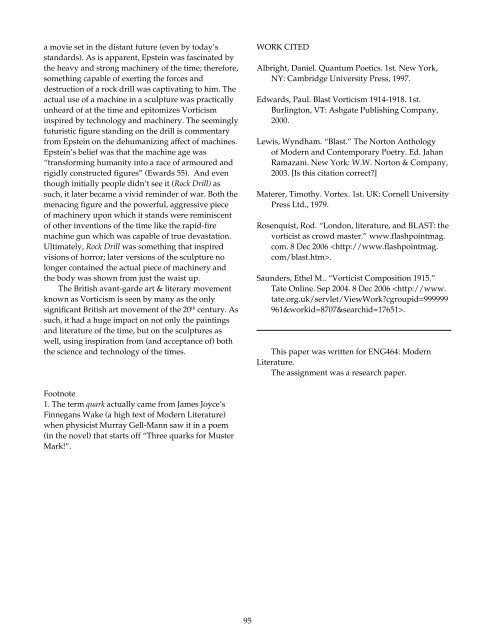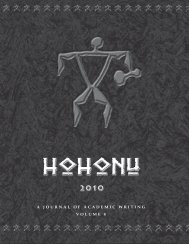A JOURNAL OF ACADEMIC WRITING VOLUME 5
A JOURNAL OF ACADEMIC WRITING VOLUME 5
A JOURNAL OF ACADEMIC WRITING VOLUME 5
Create successful ePaper yourself
Turn your PDF publications into a flip-book with our unique Google optimized e-Paper software.
a movie set in the distant future (even by today’s<br />
standards). As is apparent, Epstein was fascinated by<br />
the heavy and strong machinery of the time; therefore,<br />
something capable of exerting the forces and<br />
destruction of a rock drill was captivating to him. The<br />
actual use of a machine in a sculpture was practically<br />
unheard of at the time and epitomizes Vorticism<br />
inspired by technology and machinery. The seemingly<br />
futuristic figure standing on the drill is commentary<br />
from Epstein on the dehumanizing affect of machines.<br />
Epstein’s belief was that the machine age was<br />
“transforming humanity into a race of armoured and<br />
rigidly constructed figures” (Ewards 55). And even<br />
though initially people didn’t see it (Rock Drill) as<br />
such, it later became a vivid reminder of war. Both the<br />
menacing figure and the powerful, aggressive piece<br />
of machinery upon which it stands were reminiscent<br />
of other inventions of the time like the rapid-fire<br />
machine gun which was capable of true devastation.<br />
Ultimately, Rock Drill was something that inspired<br />
visions of horror; later versions of the sculpture no<br />
longer contained the actual piece of machinery and<br />
the body was shown from just the waist up.<br />
The British avant-garde art & literary movement<br />
known as Vorticism is seen by many as the only<br />
significant British art movement of the 20 th century. As<br />
such, it had a huge impact on not only the paintings<br />
and literature of the time, but on the sculptures as<br />
well, using inspiration from (and acceptance of) both<br />
the science and technology of the times.<br />
Footnote<br />
1. The term quark actually came from James Joyce’s<br />
Finnegans Wake (a high text of Modern Literature)<br />
when physicist Murray Gell-Mann saw it in a poem<br />
(in the novel) that starts off “Three quarks for Muster<br />
Mark!”.<br />
95<br />
WORK CITED<br />
Albright, Daniel. Quantum Poetics. 1st. New York,<br />
NY: Cambridge University Press, 1997.<br />
Edwards, Paul. Blast Vorticism 1914-1918. 1st.<br />
Burlington, VT: Ashgate Publishing Company,<br />
2000.<br />
Lewis, Wyndham. “Blast.” The Norton Anthology<br />
of Modern and Contemporary Poetry. Ed. Jahan<br />
Ramazani. New York: W.W. Norton & Company,<br />
2003. [Is this citation correct?]<br />
Materer, Timothy. Vortex. 1st. UK: Cornell University<br />
Press Ltd., 1979.<br />
Rosenquist, Rod. “London, literature, and BLAST: the<br />
vorticist as crowd master.” www.flashpointmag.<br />
com. 8 Dec 2006 .<br />
Saunders, Ethel M.. “Vorticist Composition 1915.”<br />
Tate Online. Sep 2004. 8 Dec 2006 .<br />
This paper was written for ENG464: Modern<br />
Literature.<br />
The assignment was a research paper.
















